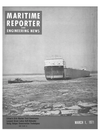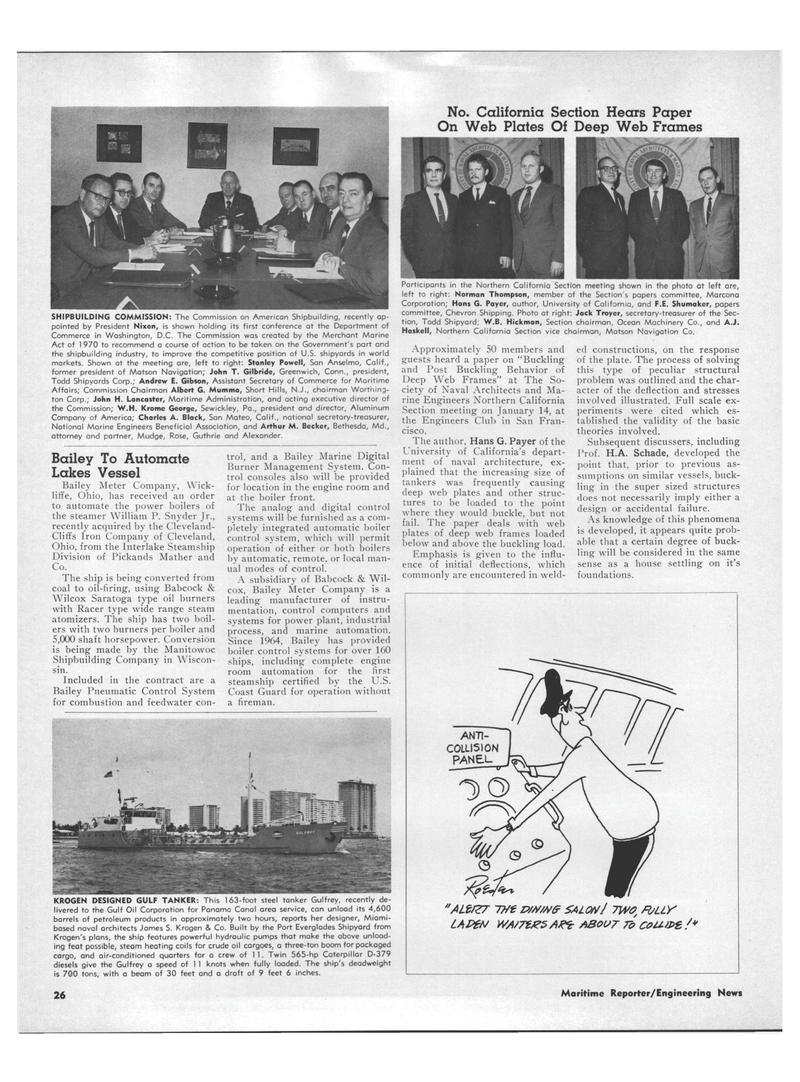
Page 24: of Maritime Reporter Magazine (March 1971)
Read this page in Pdf, Flash or Html5 edition of March 1971 Maritime Reporter Magazine
No. California Section Hears Paper
On Web Plates Of Deep Web Frames
SHIPBUILDING COMMISSION: The Commission on American Shipbuilding, recently ap- pointed by President Nixon, is shown holding its first conference at the Department of
Commerce in Washington, D.C. The Commission was created by the Merchant Marine
Act of 1 970 to recommend a course of action to be taken on the Government's part and the shipbuilding industry, to improve the competitive position of U.S. shipyards in world markets. Shown at the meeting are, left to right: Stanley Powell, San Anselmo, Calif., former president of Matson Navigation; John T. Gilbride, Greenwich, Conn., president,
Todd Shipyards Corp.; Andrew E. Gibson, Assistant Secretary of Commerce for Maritime
Affairs; Commission Chairman Albert G. Mumma, Short Hills, N.J., chairman Worthing- ton Corp.; John H. Lancaster, Maritime Administration, and acting executive director of the Commission; W.H. Krome George, Sewickley, Pa., president and director, Aluminum
Company of America; Charles A. Black, San Mateo, Calif., national secretary-treasurer,
National Marine Engineers Beneficial Association, and Arthur M. Becker, Bethesda, Md., attorney ond partner, Mudge, Rose, Guthrie and Alexander.
Bailey To Automate
Lakes Vessel
Bailey Meter Company, Wick- liffe, Ohio, has received an order to automate the power boilers of the steamer William P. Snyder Jr., recently acquired by the Cleveland-
Cliffs Iron Company of Cleveland,
Ohio, from the Interlake Steamship
Division of Pickands Mather and
Co.
The ship is being converted from coal to oil-firing, using Babcock &
Wilcox Saratoga type oil burners with Racer type wide range steam atomizers. The ship has two boil- ers with two burners per boiler and 5,000 shaft horsepower. Conversion is being made by the Manitowoc
Shipbuilding Company in Wiscon- sin.
Included in the contract are a
Bailey Pneumatic Control System for combustion and feedwater con-
Participants in the Northern California Section meeting shown in the photo at left are, left to right: Norman Thompson, member of the Section's papers committee, Marcona
Corporation; Hans G. Payer, author, University of California, and F.E. Shumaker, papers committee, Chevron Shipping. Photo at right: Jack Troyer, secretary-treasurer of the Sec- tion, Todd Shipyard; W.B. Hickman, Section chairman, Ocean Machinery Co., and A.J.
Haskell, Northern California Section vice chairman, Matson Navigation Co. trol, and a Bailey Marine Digital
Burner Management System. Con- trol consoles also will be provided for location in the engine room and at the boiler front.
The analog and digital control systems will be furnished as a com- pletely integrated automatic boiler control system, which will permit operation of either or both boilers by automatic, remote, or local man- ual modes of control.
A subsidiary of Babcock & Wil- cox, Bailey Meter Company is a leading manufacturer of instru- mentation, control computers and systems for power plant, industrial process, and marine automation.
Since 1964, Bailey has provided boiler control systems for over 160 ships, including complete engine room automation for the first steamship certified by the U.S.
Coast Guard for operation without a fireman.
Approximately 50 members and guests heard a paper on "Buckling and Post Buckling Behavior of
Deep Web Frames" at The So- ciety of Naval Architects and Ma- rine Engineers Northern California
Section meeting on January 14, at the Engineers Club in San Fran- cisco.
The author, Hans G. Payer of the
University of California's depart- ment of naval architecture, ex- plained that the increasing size of tankers was frequently causing deep web plates and other struc- tures to be loaded to the point where they would buckle, but not fail. The paper deals with web plates of deep web frames loaded below and above the buckling load.
Emphasis is given to the influ- ence of initial deflections, which commonly are encountered in weld- ed constructions, on the response of the plate. The process of solving this type of peculiar structural problem was outlined and the char- acter of the deflection and stresses involved illustrated. Full scale ex- periments were cited which es- tablished the validity of the basic theories involved.
Subsequent discussers, including
Prof. H.A. Schade, developed the point that, prior to previous as- sumptions on similar vessels, buck- ling in the super sized structures does not necessarily imply either a design or accidental failure.
As knowledge of this phenomena is developed, it appears quite prob- able that a certain degree of buck- ling will be considered in the same sense as a house settling on it's foundations.
ANTI-
COLLISION
PANEL
KROGEN DESIGNED GULF TANKER: This 163-foot steel tanker Gulfrey, recently de- livered to the Gulf Oil Corporation for Panama Canal area service, can unload its 4,600 barrels of petroleum products in approximately two hours, reports her designer, Miami- based naval architects James S. Krogen & Co. Built by the Port Everglades Shipyard from
Krogen's plans, the ship features powerful hydraulic pumps that make the above unload- ing feat possible, steam heating coils for crude oil cargoes, a three-ton boom for packaged cargo, and air-conditioned quarters for a crew of 1 1. Twin 565-hp Caterpillar D-379 diesels give the Gulfrey a speed of 1 1 knots when fully loaded. The ship's deadweight is 700 tons, with a beam of 30 feet and a draft of 9 feet 6 inches. 1© © "ALtrzr lyt z>///w& zalcwJ 7wa four
LAP£N WA/TBZSAFz: ABOUT 75 CoU)J>S /* 26 Maritime Reporter/Engineering News

 23
23

 25
25
